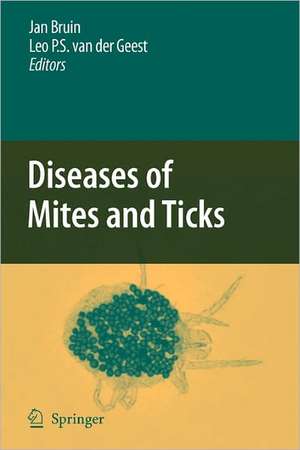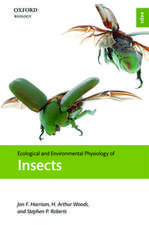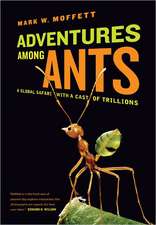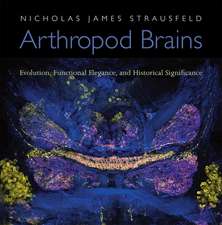Diseases of Mites and Ticks
Editat de Jan Bruin, Leo van der Geesten Limba Engleză Paperback – 19 oct 2010
| Toate formatele și edițiile | Preț | Express |
|---|---|---|
| Paperback (1) | 947.35 lei 6-8 săpt. | |
| SPRINGER NETHERLANDS – 19 oct 2010 | 947.35 lei 6-8 săpt. | |
| Hardback (1) | 955.25 lei 6-8 săpt. | |
| SPRINGER NETHERLANDS – 20 feb 2009 | 955.25 lei 6-8 săpt. |
Preț: 947.35 lei
Preț vechi: 1155.30 lei
-18% Nou
Puncte Express: 1421
Preț estimativ în valută:
181.30€ • 187.84$ • 151.31£
181.30€ • 187.84$ • 151.31£
Carte tipărită la comandă
Livrare economică 21 martie-04 aprilie
Preluare comenzi: 021 569.72.76
Specificații
ISBN-13: 9789048181858
ISBN-10: 9048181852
Pagini: 356
Ilustrații: V, 347 p.
Dimensiuni: 155 x 235 x 19 mm
Greutate: 0.5 kg
Ediția:Softcover reprint of hardcover 1st ed. 2009
Editura: SPRINGER NETHERLANDS
Colecția Springer
Locul publicării:Dordrecht, Netherlands
ISBN-10: 9048181852
Pagini: 356
Ilustrații: V, 347 p.
Dimensiuni: 155 x 235 x 19 mm
Greutate: 0.5 kg
Ediția:Softcover reprint of hardcover 1st ed. 2009
Editura: SPRINGER NETHERLANDS
Colecția Springer
Locul publicării:Dordrecht, Netherlands
Public țintă
Professional/practitionerCuprins
Diseases of mites and ticks: farewell to Leo van der Geest.- Diseases of mites and ticks: from basic pathology to microbial control—an introduction.- Using RNA interference to determine the role of varisin in the innate immune system of the hard tick Dermacentor variabilis (Acari: Ixodidae).- Silencing expression of the defensin, varisin, in male Dermacentor variabilis by RNA interference results in reduced Anaplasma marginale infections.- Potential effects of mixed infections in ticks on transmission dynamics of pathogens: comparative analysis of published records.- An association between the Antarctic mite Alaskozetes antarcticus and an entomophthoralean fungus of the genus Neozygites.- Diversity of acaropathogenic fungi in Poland and other European countries.- Entomopathogenic fungi against South American tick species.- Pathogenicity and thermotolerance of entomopathogenic fungi for the control of the scab mite, Psoroptes ovis.- Impact of two treatments of a formulation of Beauveria bassiana (Deuteromycota: Hyphomycetes) conidia on Varroa mites (Acari: Varroidae) and on honeybee (Hymenoptera: Apidae) colony health.- Topically applied myco-acaricides for the control of cattle ticks: overcoming the challenges.- Protection of Metarhizium anisopliae conidia from ultra-violet radiation and their pathogenicity to Rhipicephalus evertsi evertsi ticks.- Evaluation of Metarhizium anisopliae (Deuteromycota: Hyphomycetes) for control of broad mite Polyphagotarsonemus latus (Acari: Tarsonemidae) in mulberry.- Enabling mycelial application of Hirsutella thompsonii for managing the coconut mite.- A tale of three acaropathogenic fungi in Israel: Hirsutella, Meira and Acaromyces.- Lessons from interactions within the cassava green mite fungal pathogen Neozygites tanajoaesystem and prospects for microbial control using Entomophthorales.- Failure of the mite-pathogenic fungus Neozygites tanajoae and the predatory mite Neoseiulus idaeus to control a population of the cassava green mite, Mononychellus tanajoa.- The effects of Pseudomonas putida biotype B on Tetranychus urticae (Acari: Tetranychidae).- Overwintering and prevalence of Neozygites floridana (Zygomycetes: Neozygitaceae) in hibernating females of Tetranychus urticae (Acari: Tetranychidae) under cold climatic conditions in strawberries.- Sprays of emulsifiable Beauveria bassiana formulation are ovicidal towards Tetranychus urticae (Acari: Tetranychidae) at various regimes of temperature and humidity.- Role of entomopathogenic fungi in the control of Tetranychus evansi and Tetranychus urticae (Acari: Tetranychidae), pests of horticultural crops.- Effect of temperature on virulence of Beauveria bassiana and Metarhizium anisopliae isolates to Tetranychus evansi.- Side-effects of pesticides on the life cycle of the mite pathogenic fungus Neozygites floridana.- Natural enemies of mass-reared predatory mites (family Phytoseiidae) used for biological pest control.- Verified and potential pathogens of predatory mites (Acari: Phytoseiidae).- Symbionts, including pathogens, of the predatory mite Metaseiulus occidentalis: current and future analysis methods.
Textul de pe ultima copertă
The current collection of twenty-four papers is a mixture of primary research articles and literature reviews, presenting a broad overview of the developments in about all possible aspects of acarine diseases, stretching from basic pathology to microbial pest control. The pathogens include fungi, bacteria, and protozoa (as well as an occasional virus and unidentified organism), the hosts are mites and ticks from a great variety of taxa (e.g., Eriophyidae, Ixodidae, Oribatida, Phytoseiidae, Psoroptida, Tarsonemidae, Tetranychidae, Varroidae). These taxa include many infamous mites and ticks, which cause tremendous economical losses throughout the world, for example in greenhouse and field-grown agricultural crops, life stock (cattle, sheep), apiculture, and man. The taxa also include commercially available biocontrol agents, whose mass rearings need to be protected against pathogens.
Caracteristici
First comprehensive book on the subject of pathogens / pathology / diseases of Acari (= mites + ticks) Use of pathogens to control veterinary ticks and agricultural mite pests is a hot issue – this broad overview is therefore timely Mix of literature reviews and primary data contributions covering about all possible aspects of the subject













